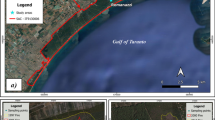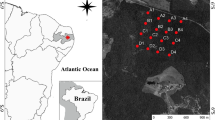Abstract
In the Netherlands, a single population of the obligate myrmecophilic butterfly Maculinea (Phengaris) teleius has survived on only 3 ha of habitat for more than 25 years, whereas at least 40 ha of habitat are thought to be required for a sustainable metapopulation. Therefore, 170 ha of farmland is being restored to wet meadows within a LIFE + project by large-scale soil excavation and hay inoculation. For successful restoration, the habitat requirements of the butterfly, with Sanguisorba officinalis as host plant and its particular life cycle as parasite of the ant species Myrmica scabrinodis, have to be taken into account. We tested whether colonization of nests of this ant species in the restoration areas is facilitated by translocation of sods collected from fen meadows. We divided 54 sods, each sized 1 m2, randomly over six patches and measured vegetation development and ant presence in the sods and surrounding control plots for 2 years. In the first summer, significantly more Myrmica ants were found in the transplanted sods in comparison to the surrounding area. Herb cover had a significant positive effect on Myrmica ant presence while it did not affect the presence of the pioneer ant species Lasius niger. In the second year, Myrmica ants were found in the surrounding control plots as well. This study contributes to the knowledge-base required for the design of restoration projects aimed at expanding the habitat of the critically endangered butterfly Maculinea (Phengaris) teleius.







Similar content being viewed by others
References
Bakker JP, Berendse F (1999) Constraints in the restoration of ecological diversity in grassland and heathland communities. Trends Ecol Evol 14:63–68
Barkman JJ (1979) The investigation of vegetation texture and structure. In: Werger MJA (ed) The study of vegetation. Junk, The Hague
Batáry P, Örvössy N, Körösi A, Valyi Nagy M, Peregovits L (2007) Microhabitat preferences of Maculinea teleius (Lepidoptera: Lycaenidae) in a mosaic landscape. Eur J Entomol 104:731–736. doi:10.14411/eje.2007.093
Boer P (2010) Mieren van de Benelux, Stichting Jeugdbondsuitgeverij
Bradley GA (1972) Transplanting Formica obscuripes and Dolichoderus taschenbergi (Hymenoptera: Formicidae) colonies in jack pine stands of southeastern Manitoba. Can Entomol 104:245–249
Bubová T, Vrabec V, Kulma M, Nowicki P (2015) Land management impacts on European butterflies of conservation concern: a review. J Insect Conserv 19:805–821. doi:10.1007/s10841-015-9819-9.
Dahms H, Lenoir L, Lindborg R, Wolters V, Dauber J (2010) Restoration of seminatural grasslands: what is the impact on ants? Restor Ecol 18:330–337. doi:10.1111/j.1526-100X.2008.00458.x
Dauber J, Wolters V (2005) Colonization of temperate grassland by ants. Basic Appl Ecol 6:83–91. doi:10.1016/j.baae.2004.09.011
Dekoninck W, Desender K, Grootaert P (2008) Establishment of ant communities in forests growing on former agricultural fields: colonisation and 25 years of management are not enough (Hymenoptera: Formicidae). Eur J Entomol 105:681–689. doi:10.14411/eje.2008.092
Donath TW, Bissels S, Hölzel N, Otte A (2007) Large scale application of diaspore transfer with plant material in restoration practice—impact of seed and microsite limitation. Biol Conserv 138:224–234. doi:10.1016/j.biocon.2007.04.020
Elmes GW, Thomas JA, Wardlaw JC, Hochberg ME, Clarke RT, Simcox DJ (1998) The ecology of Myrmica ants in relation to the conservation of Maculinea butterflies. J Insect Conserv 2:67–78
Goffart P, Cavelier E, Lighezzolo P, Rauw A, Lafontaine D (2014) Restoration and management of habitat networks for Lycaena helle in Belgium. In: Habel JC, Meyer M, Schmitt T (eds) Jewels in the mist. Pensoft Publishes, Sofia
Görn S, Fischer K (2015) Measuring the efficiency of fen restoration on carabid beetles and vascular plants: a case study from north-eastern Germany. Restor Ecol 23:413–420. doi:10.1111/rec.12203
Hannan EJ (1980) The estimation of the order of an ARMA process. Ann Stat 8:1071–1081
Hennekens SM, Schaminée JHJ (2001) TURBOVEG, a comprehensive data base management system for vegetation data. J Veg Sci 12:589–591. doi:10.2307/3237010
Hölldobler B, Wilson EO (1990) The ants. Springer, Berlin
Hölzel N, Otte A (2003) Restoration of a species-rich flood meadow by topsoil removal and diaspore transfer with plant material. Appl Veg Sci 6:131–140. doi:10.1111/j.1654-109X.2003.tb00573.x
Hula V, Konvicka M, Pavlicko A, Fric Z (2004) Marsh Fritillary (Euphydryas aurinia) in the Czech Republic: monitoring, metapopulation structure, and conservation of an endangered butterfly. Entomol Fenn 15:231–241
Jansen AJM, Roelofs JGM (1996) Restoration of Cirsio-Molinietum wet meadows by sod cutting. Ecol Eng 7:279–298
Jansen AJM, Grootjans AP, Jalink MH, Bakker JP (2000) Hydrology of Dutch Cirsio-Molinietum meadows: prospects for restoration. Appl Veg Sci 3:51–64. doi:10.2307/1478918
Tallowin JRB, Smith REN (2001) Restoration of a Cirsio-Molinietum fen meadow on an agriculturally improved pasture. Restor Ecol 9:167–178. doi:10.1046/j.1526-100x.2001.009002167.x
Klimkowska A, Van Diggelen R, Bakker JP, Grootjans AP (2007) Wet meadow restoration in Western Europe: a quantitative assessment of the effectiveness of several techniques. Biol Conserv 140:318–328. doi:10.1016/j.biocon.2007.08.024
Klimkowska A, Van Diggelen R, Grootjans AP, Kotowski W (2010) Prospects for fen meadow restoration on severely degraded fens. PPEES 12:245–255. doi:10.1016/j.ppees.2010.02.004
Knop E, Herzog F, Schmid B (2011) Effect of connectivity between restoration meadows on invertebrates with contrasting dispersal abilities. Restor Ecol 19:151–159. doi:10.1111/j.1526-100X.2010.00737.x
Kruess A, Tscharntke T (2002) Grazing intensity and the diversity of grasshoppers, butterflies, and trap-nesting bees and wasps. Conserv Biol 16:1570–1580. doi:10.1046/j.1523-1739.2002.01334.x
Lamers LPM, Vile MA, Grootjans AP, Acreman MC, Van Diggelen R, Evans MG, RichardsonCJ, Rochefort L, Kooijman AM, Roelofs JGM, Smolders AJP (2015) Ecological restoration of rich fens in Europe and North America: from trial and error to an evidence-based approach. Biol Rev 90:182–203. doi:10.1111/brv.12102
Matus G, Verhagen R, Bekker RM, Grootjans AP (2003) Restoration of the Cirsio dissecti-Molinietum in the Netherlands: can we rely on soil seed banks? Appl Veg Sci 6:73–84. doi:10.1111/j.1654-109X.2003.tb00566.x
Noordijk J, Morssinkhof R, Boer P, Schaffers AP, Heijerman T, Sykora KV (2008) How ants find each other: temporal and spatial patterns in nuptial flights. Insectes Soc 55:266–273. doi:10.1007/s00040-008-1002-9
Oates MR (1995) Butterfly conservation within the management of grassland habitats. In: Pullin AS (ed) Ecology and conservation of butterflies. Chapman and Hall, London, pp 98–112
Öckinger E, Eriksson AK, Smith HG (2006) Effects of grassland abandonment, restoration and management on butterflies and vascular plants. Biol Conserv 133:291–300
Oksanen J, Blanchet FG, Kindt R, Legendre P, Minchin PR, O’Hara RB, Simpson GL, Solymos P, Henry M, Stevens H, Wagner H (2016) Vegan: Community Ecology Package. R package version 2.3–5. https://CRAN.R-project.org/package=vegan
Peeters TMJ, Van Achterberg C, Heitmans WRB, Klein WF, Lefeber V, Van Loon AJ, Mabelis AA, Nieuwenhuijsen H, Reemer M, De Rond J, Smit J, Velthuis HHW (2004) De wespen en mieren van Nederland: (Hymenoptera: Aculeata). Nationaal Natuurhistorisch Museum Naturalis, Leiden, KNNV Uitgeverij, Utrecht and European Invertebrate Survey-Nederland, Leiden
Pontin AJ (1963) Further considerations of competition and the ecology of the ants Lasius flavus (F.) and L.niger (L.). J Anim Ecol 32:565–574
Pöyry J, Lindgren S, Salminen J, Kuusaari M (2004) Restoration of butterfly and moth communities in semi-natural grasslands by cattle grazing. Ecol Appl 14:1656–1670. doi:10.1890/03-5151
Pöyry J, Luoto M, Paukkunen J, Pykälä J, Raatikainen K, Kuussaari M (2006) Different responses of plants and herbivore insects to a gradient of vegetation height: an indicator of the vertebrate grazing intensity and successional age. Oikos 115:401–412
Reidsma P, Tekelenburg T, Van den Berg M, Alkemade R (2006) Impacts of land-use change on biodiversity: an assessment of agricultural biodiversity in the European Union. Agric Ecosyst Environ 114:86–102. doi:10.1016/j.agee.2005.11.026
Sawchik J, Dufrêne M, Lebrun P (2003) Estimation of habitat quality based on plant community, and effects of isolation in a network of butterfly habitat patches. Acta Oecol 24:25–33
Schaminée JHJ, Stortelder AHF, Weeda EJ (1996) De Vegetatie van Nederland deel 3. Graslanden, zomen en droge heiden. Opuluspress, Uppsala
Seifert B (2007) Die Ameisen Mittel- und Nordeuropas. Tauer Lutra Verlags- und Vertriebsgesellschaft. Görlitz
Settele J, Kühn E (2009) Insect conservation. Science 325:41–42. doi:10.1126/science.1176892
Sokal RR, Rohlf FJ (2012). Biometry: the principles and practice of statistics in biological research, 4th edn. WH Freeman and Co., New York
Sorvari J, Rantala LM, Rantala MJ, Hakkarainen H, Eeva T (2007) Heavy metal pollution disturbs immune response in wild ant populations. Environ Pollut 145:324–328. doi:10.1016/j.envpol.2006.03.004
Stewart GB, Pullin AS (2006) Does sheep grazing degrade unimproved neutral grasslands managed as pastures in lowland Britain? Systematic Review No. 15. Centre for Evidence-based Conservation, Birmingham, UK
Tälle M, Fogelfors H, Westerberg L, Milberg P (2015) The conservation benefit of mowing vs. grazing for management of species-rich grasslands: a multi-site, multi-year field experiment. Nord J Bot 33:761–768. doi:10.1111/njb.00966
Thomas JA, Simcox DJ, Clarke RT (2009) Successful conservation of a threatened Maculinea butterfly. Science 325:80–83. doi:10.1126/science.1175726
Török P, Vida E, Deák B, Lengyel S, Tóthmérész (2011) Grassland restoration on former cropland in Europe: an assessment of applicability of techniques and costs. Biodivers Conserv 20:2311–2332. doi:10.1007/s10531-011-9992-4
Van Langevelde F, Wynhoff I (2009) What limits the spread of two congeneric butterfly species after their reintroduction: quality or spatial arrangement of habitat? Anim Conserv 12:540–548. doi:10.1111/j.1469-1795.2009.00281.x
Van Swaay CAM, Cuttelod A, Collins S, Maes D, Munguira ML, Sasic M, Settele J, Verovnik R, Verstrael T, Warren MS, Wiemers M, Wynhoff I (2010) European Red List of Butterflies. Publications Office of the European Union, Luxembourg
Van der Hoek D, Heijmans MMPD (2007) Effectiveness of turf stripping as a measure for restoring species-rich fen meadows in suboptimal hydrological conditions. Restor Ecol 15:627–637. doi:10.1111/j.1526-100X.2007.00275.x
Wenzel M, Schmitt T, Weitzel M, Seitz A (2006) The severe decline of butterflies on western German calcareous grasslands during the last 30 years: a conservation problem. Biol Conserv 128:542–552
Witek M, Nowicki P, Sliwinska EB, Skórka P, Settele J, Schönrogge K,, Woyciechowski M (2010) Local host ant specificity of Phengaris (Maculinea) teleius butterfly, an obligatory social parasite of Myrmica ants. Ecol Entomol 35:557–564. doi:10.1111/j.1365-2311.2010.01213.x
Wynhoff I (1998) Lessons from the reintroduction of Maculinea teleius and M. nausithous in the Netherlands. J Insect Conserv 2:47–57. doi:10.1023/A:1009692723056
Wynhoff I (2008) Actie voor Pimpernelblauwtjes—Beschermingsplan voor Pimpernelblauwtjes in Noord-Brabant. Report VS2007.023, De Vlinderstichting Wageningen and Province of Noord-Brabant,’s Hertogenbosch, The Netherlands
Wynhoff I, Van Gestel R, Van Swaay C, Van Langevelde F (2011) Not only the butterflies: managing ants on road verges to benefit Phengaris (Maculinea) butterflies. J Insect Conserv 15:189–206. doi:10.1007/s10841-010-9337-8
Wynhoff I, Ens S, Vennix H (2013) Stand van de pimpernelblauwtjes in 2013. Report VS2013.26, Dutch Butterfly Conservation. Wageningen, The Netherlands
Żmihorski M, Pärt T, Gustafson T, Berg à (2016) Effects of water level and grassland management on alpha and beta diversity of birds in restored wetlands. J Appl Ecol 53:587–595. doi:10.1111/1365-2664.12588
Acknowledgements
This study was performed within the LIFE + Project “Blues in the Marshes” (LIFE 11 NAT/NL/000770/Action C1 and D1). National State Forestry and Natuurmonumenten gave us permission to access their nature reserves and carried out the transplantation experiment. Kars Veling helped in the field and documented the actions. Sicco Ens assisted collecting vegetation data. Peter Boer helped identifying the ants. IW’s work was partly funded by the Province of Northern Brabant. MPB’s work was partly funded by the Uyttenboogaart-Eliasen Society.
Author information
Authors and Affiliations
Corresponding author
Electronic supplementary material
Below is the link to the electronic supplementary material.
Rights and permissions
About this article
Cite this article
Wynhoff, I., Kolvoort, A.M., Bassignana, C.F. et al. Fen meadows on the move for the conservation of Maculinea (Phengaris) teleius butterflies. J Insect Conserv 21, 379–392 (2017). https://doi.org/10.1007/s10841-016-9941-3
Received:
Accepted:
Published:
Issue Date:
DOI: https://doi.org/10.1007/s10841-016-9941-3




